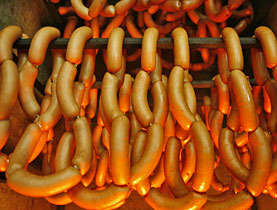
“Sausage task force” cannot help cervelat

Swiss sausage lovers face the bleak prospect of an inferior version of the iconic cervelat unless the ban of a key ingredient is lifted, Swiss meat producers warn.
An exhaustive search by a “cervelat task force” has failed to find a foolproof alternative to the Brazilian cows’ intestines that encase the nation’s favourite sausage, the industry said on Tuesday.
Brazilian skins are the only product versatile enough to provide a top quality gourmet experience when eating the sausage both raw and cooked. But imports were banned last year in response to fears over Mad Cow Disease.
The industry had pinned its hopes on scientists finding an alternative source of skins, but none of the three identified back-up solutions – artificial collagen, Uruguayan cows’ intestines and pigs’ intestines – matched the same high quality.
“There is no danger that the cervelat will cease to exist, but we have a serious problem to solve,” Balz Horber, a spokesman for the Swiss meat association, told swissinfo.
“We see some solutions but they are not yet quite suitable for our standards. These would all be stopgaps and we would much rather stick with Brazil.”
Other options, such as seaweed skin, were quickly discarded. Whereas some artificial skins tasted “mildly rancid”, others were considered to have an unacceptable colour.
Euro 2008 shortage?
One immediate concern is that some manufacturers could run out of Brazilian cow intestine reserves before this summer’s Euro 2008 football tournament, co-hosted by Switzerland and Austria.
Other producers have enough to last the year but the patchy supply has driven the price up by 30 per cent in the past few months. However, Horber insisted that this would not affect the cost of sausages in shops.
Some 160 million cervelats, weighing 25,000 tonnes, are consumed raw, fried or grilled every year in Switzerland, which has a population of 7.5 million. They make up around 30 per cent of the Swiss meat industry’s sausage output.
Swiss meat association president, Rolf Büttiker, called on the government to lobby Brussels to unblock imports from Brazil and if necessary from other countries.
National institution
Switzerland is not a member of the EU but it has signed several bilateral accords with Brussels and since April 1, 2006 it has had to adhere to a ban on using Brazilian cows’ intestines.
Horber was not over optimistic. “We’re under no illusion that we can get Brussels to change its rules quickly, so we’re hoping that they will make an exception for Switzerland,” he said.
The cervelat is a Swiss culinary institution along with other traditional favourites fondue and rösti. But while the Swiss may still be eating the sausage next year, it may not be cervelat as they know it.
“It is not just a product because it also involves our emotions,” Horber told swissinfo. “Every Swiss child has been accompanied by this sausage as they grew up.”
swissinfo, Matthew Allen in Zurich
The Swiss eat 160 million cervelat sausages every year. Inside the skins is stuffed meat from 120,000 cows and 360,000 pigs, 90 per cent of which is Swiss, every year.
The cervelat, also spelled cervelas, is made of a mixture of beef and pork.
It is eaten raw, fried or grilled.
The most popular way of cooking the sausage is speared on a stick over an open fire. Before cooking, people cut a cross at each end, so that they open up and curl back over the heat.
The name comes from the Latin cerebellum, meaning brain.

In compliance with the JTI standards
More: SWI swissinfo.ch certified by the Journalism Trust Initiative





























You can find an overview of ongoing debates with our journalists here . Please join us!
If you want to start a conversation about a topic raised in this article or want to report factual errors, email us at english@swissinfo.ch.